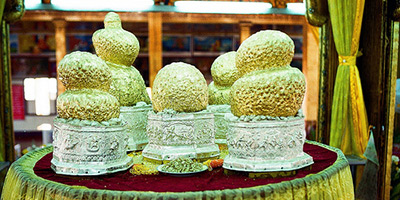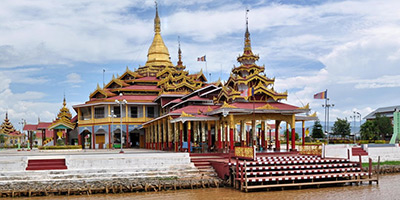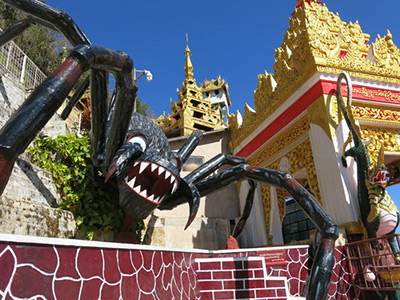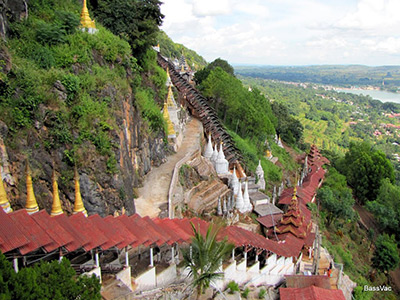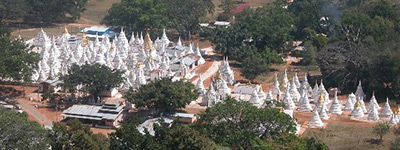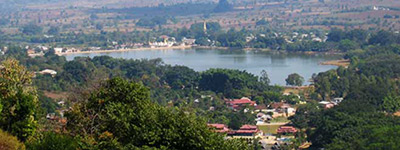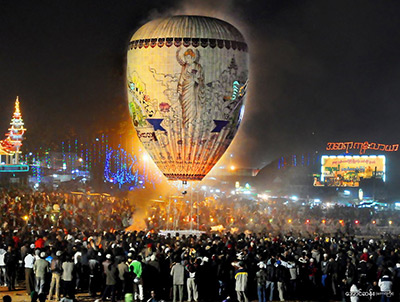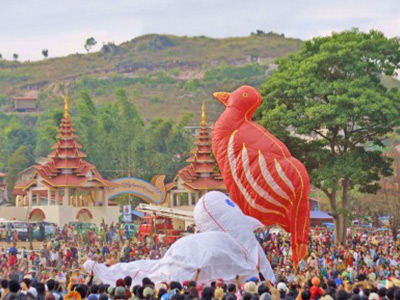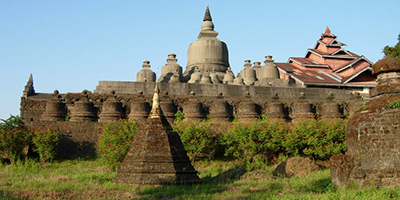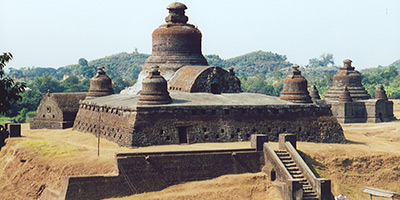Shan
Inle
This vast picturesque lake, 900 meters above sea-level, is one of the main tourist attractions in Myanmar. The lake, 22 km long and 10 km across, has a population of some 150,000, many of whom live on floating islands of vegetation. Inle Lake, natural and unpolluted, is famous for its scenic beauty and the unique leg-rowing of the Inthas, the native lake dwellers. A place we cannot miss in our itinerary is this scenic beauty of Inle Lake so at least a one-night or two-night’s stay is strongly recommended. A second night is required for those with time; extra nights allow for visits and trek to Inle Lake and Kalaw surrounding. The most convenient way is to fly from Yangon to Heho, which is the nearest airport to the lake. There are daily flights to Heho from Yangon which take about one hour. The flight from Mandalay to Heho takes only 20 minutes. Traveling by car along the uphill and winding road over the Shan Plateau, thought taking about 6 hours is interesting and well-worth taking. There is also a regular train service via. Thazi Junction to Heho and Shwenyaung, the nearest station to the Lake
Phaungdawoo Pagoda
The Phaungdawoo Pagoda is situated in Inle Lake one of the most dazzling and magical places in Asia. It is held on a grand scale for 18 days usually falls in October (sometimes in September). It is one of the famous principal shrines in Myanmar. This pagoda houses five small Buddha images once a year in end Sept-early Oct. There is a pagoda festival during which the five Buddha images are rowed around the Lake in a colorful barge. It Situated in Inle Lake one of the most dazzling and magical places in Asia. It is held on a grand scale for 18 days usually falls in October (sometimes in September). Four Buddha Images out of five from Phaung-daw-oo Pagoda are carried on royal barge and conveyed around 14 villages on the Lake. The barge is towed by the boats of leg -rowers and hundreds of boats follow the procession. The large crowds of people gather on the lake-shores to celebrate the occasion. It is really a splendid sight.Among the dance shows and fun-fairs. The most interesting event of the festival especially for foreigners is their boat race - due to their unique leg rowing. It is the one and only place in the world that one can see such marvelous act. This year Phaugdawoo Pagoda festival will begin on 26th September and end on 13th October. 2nd and 6th of October is special recommend for taking photographs.It is one of the famous principal shrines in Myanmar. This pagoda houses five small Buddha images which are much revered by the lake-dwellers once a year in late September - early October. There is a pagoda festival during which. Four of the five Buddha images tour around the lake in a colorful.
Travel Tips
Entrance Fee - US$5
The best time to visit Inle Lake is between September and March of every year.
Ngaphe Kyaung Monastery
The Nga Phe Kyaung is the biggest and oldest monastery in Inle Lake. It is a beautiful wooden structure that was built on stilts over the lake at the end of the 1850s. The monastery is home to a collection of ancient Bagan, Shan, Tibet and Ava-style Buddha images. However, it’s most famous for the jumping cats. An abbot at the monastery has trained the cats to jump through a hoop like in a circus.
Floating Market
Hand-made goods for local use and trading are another source of commerce. Typical products include tools, carvings and other ornamental objects, textiles, and cheroots.When held on the lake it, trading is conducted from small boats. This 'floating-market' event tends to emphasize tourist trade much more than the other four. A local market serves most common shopping needs and is held daily but the location of the event rotates through five different sites around the lake area (Nyaungshwe, Heho, Taunggyi, Minethauk, Shwenyaung), thus each of them hosting an itinerant market every fifth day.
Padaung
The Padaung tribe is a subgroup of the larger Kayah tribe, which in turn is a subgroup of the Karenni which in turn is a subgroup of the Karen. The Padaung have no written language and are best known for its long-necked women. The tribe is named after the Padaung area, where most of them live. There are about 10,000 people in the tribe. "Padaung" means "long neck" in the Shan anguage. Their homes and villages are found scattered in the area between the Kayah State, east of Taungoo and Southern Shan State. Some inhabit the plains in the basin of the Paunglaung River which are also part of the Kayah State east of Pyinmana. The Padaung woman's traditional attire consists of a colorful, elegant turban with a short thick loose shift and leggings. Padaung women wear a short, dark-blue skirt edged with red with a loose white tunic also trimmed with red and a short blue jacket A turban-like headscarf is draped around their head. When working they wear short- sleeved smocks. Amit R. Paley wrote in the Washington Post, “The traditional wardrobe for Padaung women is a red, saronglike dress with a blue or magenta jacket and towellike head covering. Most distinctive are the dozens of rattan rings that circle their waists.” Men wear the basic Southeast Asian longji.
Padaung Long Neck Women
The Padaung’s famous long-necked women wear brass coils---not rings---around their necks. A symbol of wealth, position and beauty, the coils can stretch their necks over a foot and weigh over 20 pounds According to the Guinness Book of Records, the world record for longest neck---15¾ inches--- belonged to a Padaung woman. The Ndebele in South Africa wear rings around their necks. Padaung means “long neck.” The coils are made from brass and gold alloy. Because long necked women can't lean their head's back, they drink from straws. According to the British journalist J.G. Scott there voices sound "as if they were speaking from the bottom of a well.” Padaung women might appear to have long necks but this is an optical illusion. As the coils are added they push the collar bone and ribs down, creating the appearance of a longer neck. Actually stretching the neck would result in paralysis and death. Removing the coils does not cause a woman's neck to collapse, although the muscles weaken. Dr. John Keshishian, an American doctor, wondered what was happening anatomically to elongate the women's neck. Did the wearing of the rings create gaps between women’s vertebrae? And if this was the case was it dangerous? After X-raying several long-necked women in Rangoon he discovered that the neck was not expanding. Rather the chins of the women are pushed up and their collarbones are pushed downwards by the weight of the coils, causing the shoulders to slope.
Pindaya
ya is a small quiet beautiful town perched on the bank of the placid Botoloke Lake. Pindaya cave is a huge extensive limestone cavern where eight thousands of Buddha images in various size and shape are installed since the 11th century not only the images with also decorated with beautiful stalagmites. The winding galleries and nooks and corners are ideal places of insight meditation since the olden days. Huge monastery compounds with numerous pagodas and temples in different stages of dilapidation are much respected by such ethnic groups as the Shans, Danus and Paos living in the environs of Pindaya
Shwe U Min Pagoda( Pindaya Cave)
There are some things we experience on our travels that somewhat mystify us and, for me, a cave high on a ridge above Pindaya was one of those. Every nook and cranny of this cave’s cavernous spaces and of its many tiny joining tunnels are adorned with over 8,000 statues and images of Buddha – huge, large, small and tiny; wood, plaster, brick, metal and marble; painted, carved and golden. I don’t begin to understand it, although it’s obviously a place of great importance to Buddhists from all over the world.The road to the cave winds and twists its way up to the high ridge above Pindaya and ends at a car park still some way from the cave entrance. Luckily for us, our driver took us even a little further up to deposit us right in front of a huge spider. Was I seeing things? Had we come to a form of Disneyland in Burma? Not really.
The Spider
Although the spider is a fairly recent touristy addition to this place of pilgrimage, it actually represents an ancient legend associated with Pindaya. The story is as long as a good storyteller, like our Sunshine, wants to make it. I have read and heard about six versions, each with its own embellishments to suit the mood of the moment for the teller and time available for the reader / listener.
Pindaya and its lake far below the cave
Essentially, the legend tells of seven fairy princesses who enjoyed coming to the lake below the cave to bathe. One night, the evening drew in before they could fly home to their kingdom. They had just time to fly up to the cave and take refuge there. While they slept, a huge spider covered the entrance to the cave with a strong web. He had his meals ready for days to come! In the morning, when they discovered their plight, the princesses did what many young maidens do in legends and stories – they screamed. And what happens then? Enter the handsome prince!
The handsome prince
As in all good fairy stories the world over, a handsome prince just happened to be passing by. He heard the cries of the beautiful princesses and, of course, came to their rescue. As he killed the spider with his arrow, he cried out “Pint-ku Ya”, a cry that later evolved into Pindaya. (In Burmese, Pint-ku means a spider, and “ya” means “I have him”.) And we all know what happens next! The handsome prince chose one of the princesses as his bride and, with varying adjustments, according to whoever is telling the story, they lived ‘happily ever after’. It was great to hear a Burmese fairy story and even better to hear the much longer version that Sunshine told us, one his Grandmother had often told him.Pindaya, is actually a Shan word meaning ‘wide plains’. As we stood on the entrance platform to the cave (added in 1925) and looked down over those plains, a fine misty rain added to the beauty of the view.
Bottaloke Lake
Pindaya is a small quiet town perched on the bank of the placid Botoloke Lake. The Pindaya cave. containing thousands of Buddha images. is the main destination in this region. Pindaya is a small quiet town perched on the bank of the placid Botoloke Lake. Pindaya cave is a huge cavern where hundreds and thousands of Buddha images in various size and shape are installed since the 11th century. The winding galleries and nooks and corners are ideal places of insight meditation since the olden days. Huge monastery compounds with numerous pagodas and temples in different stages of dilapidation are much respected by such ethnic groups as the Shans. Danus and Paos living in the environs of Pindaya.
Kalaw
Kalaw is another hill station, located 1400meters above the sea level and It is 61 km from Inle. This hill stationwas popular in the British days and it is still a peaceful and quiet place. It is also pleasantly cool and a good place for hiking through bamboo groves and rugged mountain scenery. The main attractions of Kalaw are the town itself, with its mock-tudor colonial bungalows, its ethnic mix of people, and it's setting within trekking distance of many ethnic minority villages.
Taunggyi
Taunggyi is situated in the southern Shan State and is the capital town of Shan States. It is 4.712feet above the sea level and has a moderate climate. It is also located about 500 kilometers north of Yangon and about 10 kilometers southeast of Mandalay. The capital city of the Shan State is situated on a high plateau surrounded by high mountains. It is situated on a high plateau surrounded by high mountains. As Taunggyi lies on a hill region. The atmosphere is conducive to good health especially by means of the salubrious mountain air. It usually rains in Taunggyi from June to November and average annual rainfall is 32.68 inches. To reach Taunggyi you first have to fly to Heho about 40 kilometers to the West because the town itself does not boast an airfield.Taunggyi can be reached by road rail or air from all parts of the country. The distance between Yangon and Taunggyi is 456 miles and can be reached by road directly. The road to Taunggyi is full of bends and zigzags and. seen from above resembles a snake. One can have a good view of the surrounding area while travelling along this road. As soon as you enter Taunggyi. The magnificent Sao Sam Htun Hospital can be seen first and further on there are the Taunggyi Department Store the market. Dhammayon (congregation hall). Agricultural Bank. cinemas and shops and stores, restaurants, churches. Shan State Cultural Museum. Taunggyi Degree College. The golf course and residential buildings. There are pines. cherry and eucalyptus trees growing all over the town and the whole area is green and pleasant. The busiest part of Taunggyi is the Myoma Market. A place where people from the environs used to flock only once every five days to buy and sell their regional products. Now it has become a daily market and is constantly crowded with people. It is also the gathering point of different national races residing in Taunggyi.
Mrauk-U
A new tourist site, which is becoming increasingly more popular in recent years, is the old capital of Rakhine (Arakan) called Mrauk U, a town 80 kilometres from the north of Sittwe. Local people refer to it as Myo Haung, the old city. It is situated in Rakhine State, on the southwestern part of Myanmar. It was first founded by The Rakhine King Min Saw Mon in 1430 AD and flourished until 1784 AD.Mrauk U was once known as the Golden City by foreign travellers due to its strategic location on the costal region of Bay of Bengal and being a focus of trade. The early 17th century was Rakhine Golden Age for its trading with western countries such as Netherland, Spain, Portugal, Italy and south India. It was an important free trade port and is now an archaeological complex with several very interesting buildings and temples. In its heyday, Mrauk U was one of the richest cities in all of Asia and there are many places of interest to visit in the ruins of this once great city.Mrauk U, a prominent capital, was carefully built in a strategic location by leveling three small hills. The pagodas are strategically located on hilltops and serve as fortresses. They were once actually used to prevent enemy intrusion. There are moats, artificial lakes and canals and the whole area could be hooded to repulse attackers. All over the old city and the surrounding hills are dotted with in numerable pagodas and Buddha images. Among many in ruins, some are still being used as places of worship today and some are now being restored to their original splendor.Mrauk U can easily be reached via Sittwe, the capital of Rakhine State. From Yangon, there are daily flights to Sittwe and there are small private boats as well as larger public boats plying through the Kaladan River to Mrauk U. Fly up to Sittwe, the nearest gateway to Mrauk U from where a five-hour boat riding will take you to Mrauk U.The legendary Shittaung Pagoda, ordination halls and tattooed Chin women are some of the highlights in Mrauk U. A tour through Myanmar would not be worth while without exploring Mrauk U, an ancient city that reflects the different characteristics of cultural and religious heritage of Myanmar.
Shit Thaung Pagoda
Shit Thaung Temple (Temples of 80000 pagodas) built in 1536 AD in Mrauk Oo, northern Rakhine state of Myanmar. The first terrace is 40 feet high and the walls are built with stone blocks. On the upper platform there are stone wall 9 feet think and 12 feet high on the west and south sides. Along the south and north walls there are brick pagodas. The main shrine is said to encase 84000 holy relics and are dedicated to the 84000 future Buddha’s. And this temple became known as temple of 80000 pagodas. The temple is the tunneled structure with the main cave hall surrounded by tunnels and also connected to a prayer hall.


